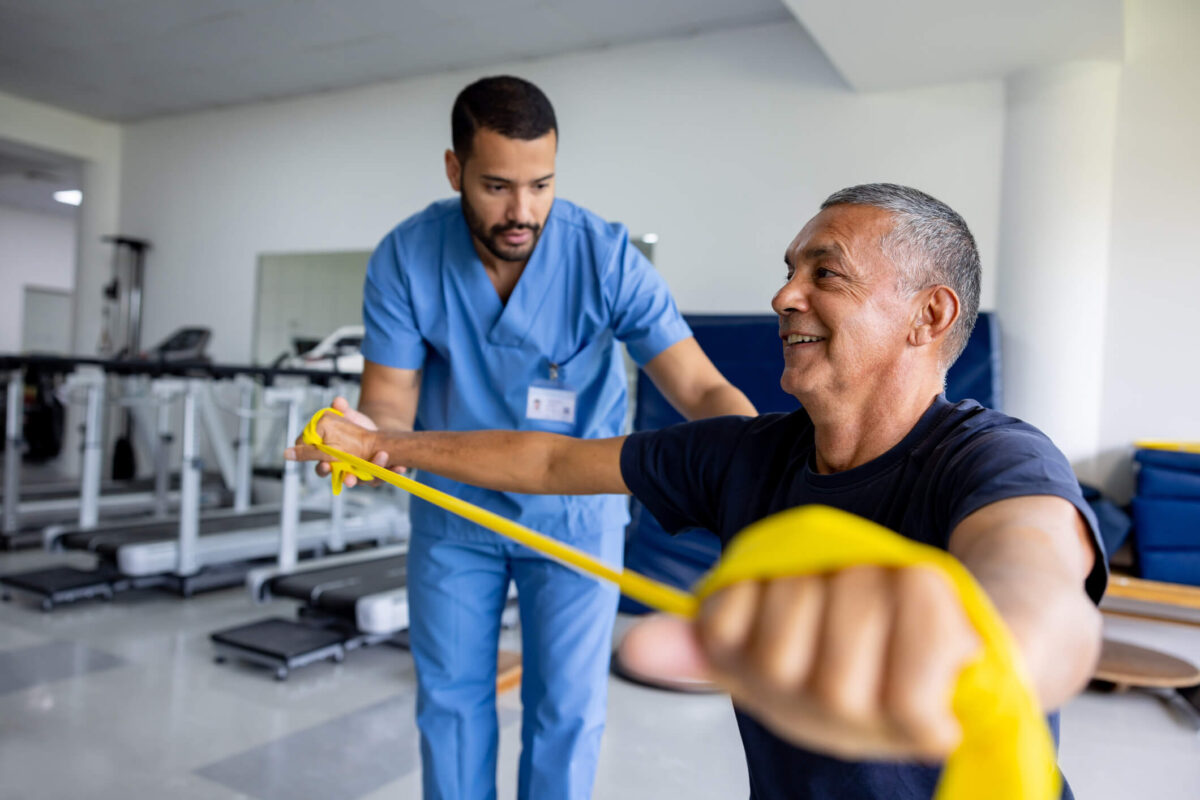Are you actively seeking a career in physical therapy? If so, you need to make sure that your LinkedIn profile is in tip-top shape so you can stand out as a leading candidate for physical therapy job postings. Whether you’re pursuing a clinical or non-clinical physical therapy role, optimizing your LinkedIn profile could save you weeks or months worth of time spent in a job search.
Upstream Rehabilitation and our family of brands are hiring passionate individuals who are looking to make a difference in our patients’ lives at our nationwide clinics. Take a look at some of the best ways you can enhance your LinkedIn profile to help you stand out as a leading candidate for physical therapy job postings.
19 Tips to Enhance Your Physical Therapy LinkedIn Profile
Optimize Your Job Title and Headline
One of the quickest things you can do to enhance your LinkedIn profile is to make sure that you’ve selected or set a strong headline and job title. If you’re pursuing a clinical physical therapy role, it might be confusing for viewers who take a look at your LinkedIn profile to see a previous position or internship job title you had that isn’t related to physical therapy. For most individuals, the job title will be outdated from when you last updated your profile.
Make sure that the job title on your LinkedIn profile reflects the position you’re pursuing, and use the headline to grab the attention of individuals who click on your profile. Use it as a callout section to highlight that you’re actively seeking a physical therapy position.
Improve Your About Section
The about section on your LinkedIn profile can serve as a career objective, summary, and highlight reel for your professional accomplishments. Try to create an about section that serves all three purposes if you’re actively seeking a new role. If you’re not currently pursuing a new role but you’d be open to opportunities, then you can just have a career summary with a highlight reel of your accomplishments. Your about section in your profile should be no longer than 3 to 4 sentences and should give a quick bite of information for potential visitors. If other LinkedIn users or potential connections are interested in learning more about you, they can either reach out to you or can scroll further down your profile to learn more.
A strong about section on your LinkedIn profile should entice readers to learn more about you as a professional. You want to clearly establish who you are, mention your expertise, and give a callout to some of your professional achievements.
Avoid Fancy Buzzwords
When building your LinkedIn profile, it may seem like you need to include a bunch of fancy language or buzzwords to get people interested. As you’re building out your profile, avoid using any type of fancy language that might be offputting to readers or confuse them about your intent. Instead, try to craft your profile like you’re talking directly to an interested reader.
Use a Professional Photo
You don’t need to pay for a fancy photographer to take a good professional photo for your LinkedIn profile. If you can, try to find a solid color backdrop, prop up your phone, and set the timer for a few seconds. A professional and appropriate photo can send a strong message that you’re a candidate they should take seriously, and you can avoid appearing unprofessional by using inappropriate or older photos. It’s important to remember that at its core, LinkedIn is a social media platform meant for professional connections, and the photo you select should reflect your professionalism. Put your best foot forward and create a strong first impression with a professional photo.
Begin Building Out Your Professional Network
The next thing you can do to enhance your LinkedIn profile is to begin building out your professional network. LinkedIn has many great features, including its ability to present individuals you may know to help bolster your professional network. LinkedIn will provide recommendations for you to connect with based on previous employers, current employers, previous and current education, shared groups, and more.
Avoid sending out too many network invites to an abundant amount of people you don’t know. Instead, try to make meaningful connections on LinkedIn by finding people you might be able to strike up a conversation with. As you’re getting ready to send that connection request, type up a brief message on who you are and share why you’re hoping to connect with them.
One of the best things about building out your professional network is that you can try and build meaningful connections with potential recruiters, hiring managers, and individuals who might make that referral if they know of companies who are hiring, like Upstream Rehabilitation and our family of brands.
Select Relevant Skills for Your Profile
Another robust feature on LinkedIn is the skills section. With millions of users who have selected or submitted their own skills on the platform, there is an abundant amount of skills to choose from which will help you accurately reflect your capabilities and expertise. LinkedIn allows you to select up to 50 total skills, and you can highlight some of your top skills on your profile. In addition, others can endorse your skills if you request them to, which can help reaffirm your abilities to others who view your profile.
As you’re building and looking to enhance your LinkedIn profile, make sure that you select relevant skills for the positions you’re applying for. In doing so, you can also be matched for potential positions that have listed certain skills as required or preferred in the job posting.
Focus on selecting hard skills first, and then if you have leftover skills you can consider adding soft skills to make your skills section more robust.
Consider Completing Some Skills Assessments
LinkedIn also has skills assessments you can complete. If you’ve asked for a few endorsements and some of your connections are slow to provide them, you can also complete skills assessments which are short quizzes that will put your skills to the test. Successful completion of these can reward skills assessment badges which you can share and highlight on your profile.
Ask For and Provide Recommendations and Endorsements
The next thing you can do to enhance your physical therapy LinkedIn profile is to ask for and provide recommendations or endorsements for your professional connections. Endorsements and recommendations can help you highlight individuals you’ve worked with in the past, call attention to their skills, and in return, they can do the same for you. Endorsements and professional recommendations on your profile can both reaffirm your ability to work with others and be another fantastic way of having someone speak highly of your skills.
Be selective with who you ask for recommendations and endorsements from, and be open to providing one in return for them. A few recommendations and endorsements from connections in your professional network can go a long way.
Follow Relevant Pages and Engage/Comment on Articles You Find Interesting or Relevant
Following relevant pages, influencers, and groups on LinkedIn can present plenty of opportunities for you to see what’s trending in the professional world, find interesting articles, and give you a chance to comment or engage with posts. Engaging and commenting on posts you find interesting or relevant can also be a great way to build connections with like-minded individuals and add to meaningful discussions on the platform.
Double-Check Your Profile and Account Settings
The profile and account settings of your LinkedIn profile may seem overwhelming at first, but the robust features allow you to tailor your experience on the platform. One important thing to check is to make sure that your profile can be viewed by others. If your profile is set to private, it may make it nearly impossible for others to naturally discover your profile or to view what your profile has to offer. Make sure that your settings are correct to allow others to view your profile, send connection requests, and more.
Set Your Job Status to Open To Work
Actively seeking a new physical therapy position? If so, make sure that your profile has the Open to Work setting. In doing so, a nice badge will appear on your profile picture which will let others know that you’re currently seeking physical therapy positions.
Review the Contact Section
The contact section of your profile plays a key role in how others communicate with you. While individuals can reach out to you through the platform itself, you also want to make sure that the contact section of your profile is up to date and has all the relevant information others might need if they’re looking to communicate with you. Make sure that your LinkedIn profile contact section has important details like your phone number and a professional email address. If a physical therapy recruiter, hiring manager, or HR professional wants to get in touch with you regarding a role, they might do so offline and would rather use one of the other contact methods as opposed to reaching out on LinkedIn.
Customize Your Profile URL
The next easy way to enhance your LinkedIn profile is to set a custom profile URL. When you’re building your LinkedIn profile, it might automatically generate random characters to be appended to your profile URL. Instead, you can set it to something simple and easy, which you can then include on your resume to give others a chance to quickly search and view your LinkedIn profile where they can browse for more information.
Take a look at this helpful guide to see how to customize your LinkedIn URL.
Include Up to Date Education
As you begin building out and expanding other areas of your LinkedIn profile, pay close attention to your education section. Check to verify that your education section is up to date with correct attendance and graduation dates and there are no misspellings in the degree, location, or school.
Optimize Your Work Experience
The next section you’ll need to review to optimize and enhance your LinkedIn profile is arguably the most important section, the professional work experience. This section is what your reviewers will look at most. Each position you include on your LinkedIn Work Experience section should include a short summary of your responsibilities, the skills you used, and the impact or accomplishments you had in the role. The short summary of your responsibilities should be a 2 to 4 sentence brief overview of what your role entailed. From there, highlight 3 to 5 bullet points of the impact you had or the accomplishments you achieved while in the role.
As you’re writing up each role you’ve had, it’s important to keep in mind that you want to not only explain your previous positions, but you want to highlight how you clearly made an impact and detail how your experience in those prior roles would make you a good fit for future positions. As you grow more experienced throughout your career, you can choose to leave off irrelevant positions or junior-level positions that are decades old, including the ones you held while you were in high school.
Add Relevant Certifications
Including relevant certifications can enhance your physical therapy LinkedIn profile and help you separate yourself from the competition as you begin applying to relevant PT job openings. Make sure you include up-to-date certifications and double-check older ones on your profile to confirm that the dates are accurate if you’ve recently had them renewed.
Highlight Publications or Relevant Articles You’ve Written
Working in healthcare and physical therapy can also present research and publication opportunities which can really beef up your resume and LinkedIn profile. If you can do so, include any relevant publications or articles you’ve been featured in or had published.
Don’t Forget to Proofread
Building out a robust LinkedIn profile can take lots of effort and requires extensive writing, which is why you need to make sure you remember to proofread and check for simple grammatical errors, spelling mistakes, or typos along the way. Don’t hesitate to double-check or even triple-check sections as you go or once you finish. A few minutes of reviewing your own work will help you ensure that you’re putting your best foot forward and creating a strong impression on other professionals who take the time to review your profile. It can also be beneficial in asking a friend or family member to take a few minutes out of their day to review your profile to see if they’ve got any other changes they would recommend making.
Create a Post
The next thing to do, once you’ve done all the steps above and enhanced your physical therapy LinkedIn profile, is to create a post and let others know about your physical therapy job search. Create a post to let others know that you’re actively searching for a new physical therapy position and would take recommendations or referrals for physical therapy job postings. In doing so, you can leverage the professional network you’ve worked to develop, and you can let others know that you’re actively pursuing a new position.
Pursue a Physical Therapy Career with Upstream Rehabilitation!
Upstream Rehabilitation and our family of brands are actively hiring for clinical and non-clinical physical therapy job openings across the country in our ever-growing locations. If you’re passionate about helping individuals alleviate pain, improve function, and get back to doing the activities they love most, then you should apply to our open physical therapy job postings.
Search and apply to physical therapy job openings with Upstream Rehabilitation and see why many are choosing Upstream careers!




